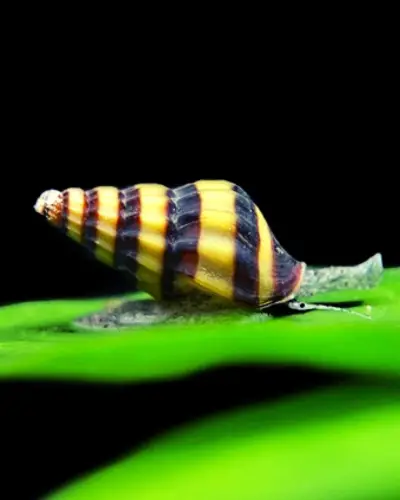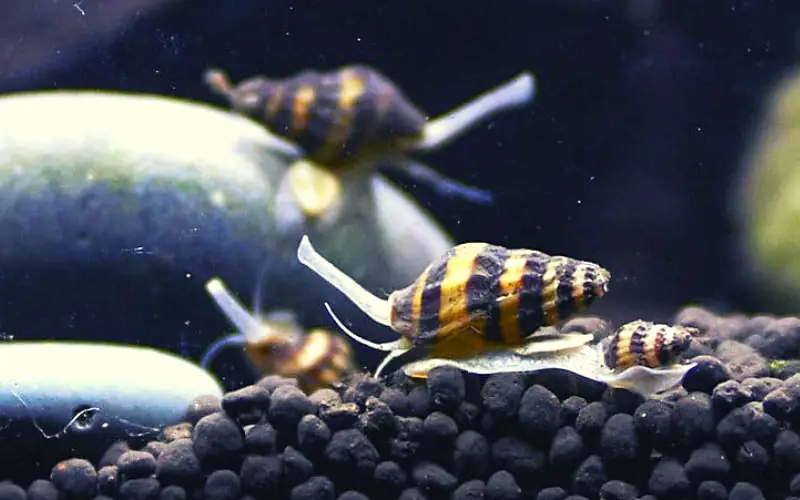How long do assassin snails live in home aquariums? Assassin snails are popular for aquarium enthusiasts looking to control pest snail populations in their tanks.
These tiny, carnivorous snails are known for their ability to hunt down and devour other snails, making them a valuable asset in maintaining a healthy tank ecosystem. But how long do these voracious predators live in aquariums?
In this ultimate guide, we will explore the lifespan of assassin snails in tanks, considering factors such as tank size, water conditions, and diet.
We will also discuss how to care for these snails to ensure they thrive and reproduce in your aquarium.

Whether you are a seasoned aquarium hobbyist or a beginner looking to learn more about these fascinating creatures, this guide will provide valuable insights into the life expectancy of assassin snails in captivity.
Table of Contents
ToggleHow Long Do Assassin Snails Live for?
Assassin snails have a lifespan of around 2-3 years but can live longer with proper care. To ensure the longevity of your assassin snails, it is essential to maintain good water quality and water parameters, perform regular water changes, and provide a balanced diet.
When keeping assassin snails, it is crucial to consider their compatibility with other tank inhabitants. Assassin snails may also be interested in baby snails or snail eggs. Be cautious when adding new assassin snails to a tank with existing populations of some other freshwater snails.

Additionally, ensure the display tank water is free from toxic substances that can harm the assassin snails. Keeping assassin snails in a group rather than individually is recommended, as social creatures prefer Company.
With proper care and attention to their needs, assassin snails can thrive and help control unwanted snail populations in the aquarium.
Assassin Snail and Pest Snails Control
Assassin snails (Clea helena) are a natural solution for controlling pest snail populations in aquariums. They are aptly named for their predatory habits, feeding primarily on other snails.
This makes them a valuable addition to a tank overrun with pest snails like bladder, ramshorn, Malaysian trumpet, and pond snails.
Benefits of Assassin Snails
- Effective pest control: Assassin snails are efficient hunters and can significantly reduce pest snail populations.
- Safe for plants: Unlike many other snail-eating fish, assassin snails won’t harm your aquarium plants.
- Low maintenance: They don’t require any special care beyond the usual aquarium maintenance.
Things to Consider
- Not algae eaters: Assassin snails are not a substitute for algae-eating snails. They primarily focus on hunting other snails.
- May target beneficial snails: If you have desirable snail species in your tank, assassin snails might see them as prey, too.
- Feeding after pest snails are gone: If the pest snail population is under control, you might need to supplement their diet with sinking carnivores or shrimp pellets.
Overall, assassin snails are a natural and effective way to control pest snail populations in aquariums. However, it’s important to consider their limitations and ensure they are compatible with your other tank inhabitants.
Do Assassin Snails Eat Other Snails?
Assassin snails are known to be carnivorous and will eat other freshwater snail species in the aquarium. They will target smaller snails like trumpet snails, ramshorn snails, and pond snails.
Even snails with an operculum are not safe from the hungry assassin snail. Assassin snails feed on whatever food is most appropriate for them, but they do not seem interested in larger snails like apple snails or Malaysian trumpet snails.
Assassin snails are commonly kept in freshwater tanks to control snail populations. It is important to note that assassin snails should be well-fed to prevent them from preying on other snails in the tank.
When it comes to assassin snail care issues, providing them with a suitable environment and high protein food is essential. They prefer to eat smaller snails like ramshorn snails and pond snails, but they will also consume shrimp if given the opportunity.
They are generally safe to keep with fish that share the aquarium, as they mainly focus on snails as prey. In terms of breeding, assassin snails reproduce by laying eggs, and a group of assassin snails may produce baby assassin snails over time.
Assassin Snail Care (Best Practices)
Assassin snails, also known as bumblebee snails (Anentome helena or Clea helena), are freshwater snails famous for keeping pest snail populations in check. Here’s a rundown on how to care for them:
Habitat:
- Tank size: While some sources say a 10-gallon tank is enough, a minimum of 30 gallons is recommended for 10-15 snails [1]. Larger tanks provide more stability in water parameters.
- Substrate: A soft substrate like sand is ideal for burrowing and hunting, but gravel works too [2, 3].
- Water parameters: Assassin snails are adaptable but prefer stable conditions. Aim for:
- pH levels: 7.0 – 8.0 [1].
- Temperature: 64-85 degrees Fahrenheit [1].
- Hardness: moderately hard water (2-15 dKH) for assassin snail’s shell health [2]. Avoid copper, which is toxic to snails [4].
- Filtration: A cycled tank with good filtration is necessary [2].
- Décor: Assassin snails don’t have specific needs, but planted tanks are beneficial as they help maintain stable parameters and provide hiding spots [2].
Feeding:
- Assassin snails are carnivores and primarily eat other snails. If pest snails in the tank are scarce, supplement their diet with:
- Blanched veggies like zucchini or spinach [3].
- Sinking fish food [3].
- フレークフード (furēku fūdo, flake food) [Japanese for sinking fish food]
Tankmates:
- Avoid tankmates that can be eaten by assassin snails, including shrimp and small snails [2, 5].
- Peaceful community fish like tetras, catfish, and angelfish are good options [4].
Additional Tips:
- When introducing assassin snails to your tank, acclimate them properly to avoid stress [4].
- Monitor your tank for empty snail shells to ensure the assassin snails have a food source [6].
- Assassin snails can reproduce quickly if there’s an ample food source [4].
By following these best practices, you can create a thriving environment for your assassin snails and keep your aquarium pest snail population under control.
Breeding Assassin Snails And Reproduction: (Assassin Snail Breeding)
You will need both a male and female snail to breed assassin snails. These snails are generally safe to keep with other snails in breeding tanks, such as nerite snails and rabbit snails.
Assassin snails need a diet of other aquarium snails and do not seem interested in snails without an operculum. If you add assassin snails to your aquarium, provide them with a suitable environment, such as hiding spots and clean aquarium glass.
Assassin snails do not seem picky eaters and will choose whatever food is available to them. However, they typically do not feed on apple snails.
Unlike other snails that require plants to eat, assassin snails can survive on a diet of other freshwater snails. These snails are freshwater and do not need to come up for air like most other aquarium snails.
Assassin Snails and Compatible Tank mates
Assassin snails like to hunt and consume their prey, and they have a unique ability to track down and eliminate unwanted snails in the aquarium. Despite their predatory nature, assassin snails sometimes don’t feed on apple snails and other larger snail species.
However, when it comes to smaller snails, assassin snails really excel at keeping their population in check. If you have assassin snails in your aquarium, they can be found preying on pest snails soon after being introduced.
Assassin snails do well with tank mates who are not potential prey, such as shrimp and some fish species. So, if you’re looking for an effective way to handle unwanted snail populations, consider adding assassin snails to your tank.
Commonly Asked Questions about How Long Do Assassin Snails Live For (FAQs)
What do you feed assassin snails?
Assassin snail feeds on other freshwater snails. But they’ll also scavenge for leftover fish food, brine shrimp, algae, or even dead fish.
What kills assassin snails?
Assassin snails die from copper exposure, crushed shells, starvation, or particular fish predators.
Do assassin snails clean tanks?
Assassin snails won’t clean your tank, but they can control pest snail populations by hunting and eating them.
How effective are assassin snails?
Assassin snails can effectively control pest snail populations in aquariums, but results depend on tank size and initial infestation.
Do assassin snails eat algae?
Assassin snails are primarily carnivorous, and algae isn’t their primary food source. They might scavenge for it if hungry, but other options are preferred.
How long can assassin snails go without food?
Assassin snails can survive for weeks without food, entering a dormant state if necessary. But for long-term health, offer them prey or scavenging options.
How long do assassin snails take to grow?
Assassin snails reach full size in about 6 months, growing to around 1 inch long.
Conclusion
In conclusion, understanding the lifespan of assassin snails is crucial for any aquatic enthusiast. These fascinating creatures play a vital role in maintaining the delicate balance of our aquarium ecosystems. By introducing assassin snails into your tank, you can effectively control the population of pest snails and keep their numbers in check. Additionally, their lifespan gives us a sense of responsibility to ensure optimal care and conditions for them to thrive.
While the lifespan of assassin snails can vary depending on various factors, including water parameters and diet, they typically live for about two to three years. So, if you’re considering adding these remarkable snails to your aquarium, be mindful of their needs and provide them with a suitable environment to maximize their lifespan. Now you know the answer to the question, “How long do assassin snails live?”
You might also like
- Will Assassin Snails Eat Nerite Snails: (The Shocking Truth)
- Assassin Snail Lifespan in Tanks: (Comprehensive Care Guide)
- Do Assassin Snails Breed Quickly in Tanks: (Ultimate Guide)
- How Many Assassin Snails Per Gallon: (The Ultimate Solution)
- Warning: Assassin Snail Size Reveals Deadly Secret Weapon!
- Assassin Snail Water Temperature 101: (Clea Helena Expert Advice)
- Can Assassin Snails Live in Cold Water Aquarium: (A Detailed Answer)
- Full Grown Assassin Snail in Aquarium: Eliminate Pest Snails!
- Snail Assassin Snail Water Parameters: (Care Guide & Tank Set-Up)





